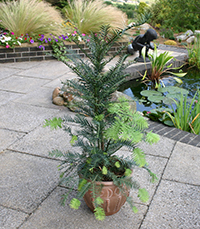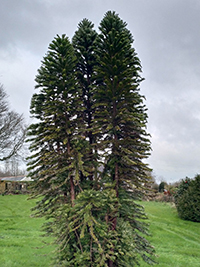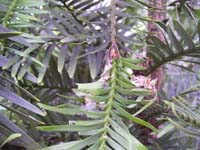Taking Care of a Wollemi PineThe Wollemi Pine, the ultimate survivor, is proving to be hardy and versatile in cultivation. It is not only attractive and striking in appearance, it is easy to grow and low maintenance.
It will adapt to a diverse range of climatic zones, thriving in full sun to semi-shaded outdoor positions.
It is a stunning feature tree for large gardens and parklands. It can be maintained in a pot almost indefinitely, so is well suited to patios, verandahs and courtyards. It can also be used as indoor decoration in well lit areas as it is able to tolerate air-conditioning.
|
 Growing in a container (inside or outside)Wollemi Pines are perfect for patios, verandas and balconies if able to be kept well-watered through the main growing months of spring and summer.
If required, plant growth can be controlled in a number of ways to suit any situation by:
a. Increasing, or restricting the container size
b. Altering the fertiliser levels
c. Pruning the apical shoots and fronds to suit
Container Choice
The container size can vary from something containing 10 litres up to 100 litres of compost, depending on the size of specimen that you eventually desire. We suggest not to 'over pot' the Wollemi Pine. Ideally the roots should be able to reach the sides of the new pot within a year of planting. Transferring the tree from its original smaller pot into a one between three and ten times its volume, will suffice for many years.
Potting
We recommend a reduced peat, or peat free compost. Most proprietary tree and shrub, or ericaceous composts will be suitable. Ensure there is a drainage hole in the base of the chosen container allowing excess water to drain. Place some grit, stones, or earthenware 'crocks' in the bottom of the pot. Knock the tree out of the original pot and put it into the new container, so that the original surface is just below the new compost. Apply enough water so that water is
seen to leach out of the bottom of the pot. Staking should not be necessary, but if you do want to control one of the lead stems', or are in a windy location, stability can be enhanced with a tree stake and tie.
Watering
Water the tree by saturating the plant as thegrowing media becomes dry in the top 5cm of the pot.This may be once, or twice a week in summer and less, if at all in winter. As a general rule, the lower the light level and temperature, the less water is required. Wollemi Pine do not like 'wet feet' and will not tolerate over watering. It will not survive if it is held for excessive periods in constantly wet compost. During the key growth period of spring and summer however, your tree is likely to be thirsty. Ensure to prevent the new foliage from drying, but avoid keeping the plant 'sitting' in water constantly throughout the year.
Fertiliser
As mentioned previously, growth can be controlled easily. If you wish to have a larger plant, the addition of a low phosphate ‘controlled release’ fertiliser at 5g (one teaspoonful) per 3 litres of
compost applied to the top surface, twice a year in the summer will help active growth. Alternatively use a water-soluble fertiliser, such as an Ericaceous fertiliser, once a month during the growing season will provide similar nutrition. If the tree becomes too big for the pot, either replant into a bigger container, or prune the plant in early spring.
Location
For an outdoor living area such as a balcony, courtyard or patio, choose a well-lit location;
Preferably not exposed to the full sun in mid-summer. If the tree is to stand outside over winter, choose a sheltered position and make sure that the compost does not become over-saturated by rain through winter. If placed directly from shade into the full sun, the plant may develop some initial tip-burn and yellowing of the foliage. This is not uncommon for rainforest and Araucariaceae species. It should, however, regain its normal deep green appearance
over a few months and thrive.
Does The Wollemi Pine make a good house plant?
Wollemi Pine will also make a good houseplant. You can enjoy watching your tree grow and observe the extraordinary features as it matures. If kept indoors, place the plant in a very well-lit position but out of the full sun in mid-summer. From May to September it will appreciate a ‘holiday’ outside for a few days a month. In many cases we have seen people bringing the plant inside in winter and taking it out during the summer months.
|
 Growing the Wollemi Pine in the groundTiming
The best time to plant the Wollemi Pine is in late spring as the ground starts to warm and the winter frosts cease.
Location
Choose a location, ideally sheltered from the coldest winds and hardest frosts. Full sun or partial shade is ideal. If the Wollemi Pine is to be grown as a large specimen, the spacing around the tree from other trees and shrubs should be at a minimum of 3m and preferably even more. If a grove or hedge effect is intended and you wish to control growth by pruning, then the planting can be as little as 2m apart.
Planting
Dig the hole at least twice the size of the original pot and mix some organic material such as leaf mould or green compost, a sprinkling of low phosphate general fertiliser around the sides of the hole, or with the back fill. In its natural habitat, the pH is exceptionally low but our experience is that the Wollemi Pine will grow happily in a pH range of 4.5 to 7, but a pH below 6 is preferable.
The Wollemi Pine does not like 'wet feet' so a well-drained soil is best. If the soil is heavy clay or overlying clay, it is advisable to use some well drained loam-based compost as back fill in the planting hole. Carefully knock the plant out of the pot and place so that the original compost is just below the surface of the new hole. Firm the soil around the tree and, if in windy position, stake and tie.
Watering
Water the tree in well and apply weekly water in dry periods throughout the first season to establish the plant. After the initial establishment, the tree will withstand quite dry conditions, but may need watering in extreme heat.
|







